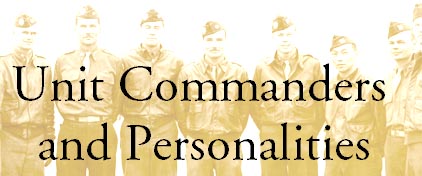
MARK BANDO'S WEBSITE
General BILL LEE
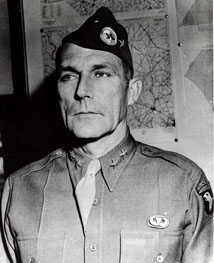 General William C. Lee, a native of Dunn, N.C., was one of the pioneer officers in the U.S. Airborne and was instrumental in "writing the book"on early practices and procedures. As such, he became known to many as "The Father of the U.S. Airborne."
General William C. Lee, a native of Dunn, N.C., was one of the pioneer officers in the U.S. Airborne and was instrumental in "writing the book"on early practices and procedures. As such, he became known to many as "The Father of the U.S. Airborne."
Born in 1895, General Lee commanded the Provisional Parachute Group at Ft. Benning, starting in March of 1941. When the 101st Airborne Division was activated in 1942, General Lee became the original Division commander.
Bill Lee led the Screaming Eagles through training and took the division to England in mid 1943. A few months before D-day, General Lee suffered a heart attack and had to relinquish his command to Maxwell Taylor. General Lee returned to the Zone of Interior, where he
avidly followed the exploits of his beloved division as they fought through Normandy, Holland and the historic defense of Bastogne. In tribute to General Lee's legacy to the division, all 101st paratroopers were instructed to shout "Bill Lee" when jumping into Normandy.
General Lee sadly died a few short years after WW2 ended, but his former residence in Dunn, N.C. is now a museum, which preserves the history of
his life and Army career. U.S. Army photo
General MAXWELL D. TAYLOR
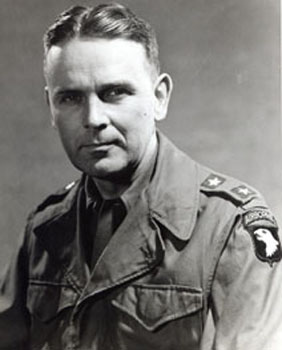
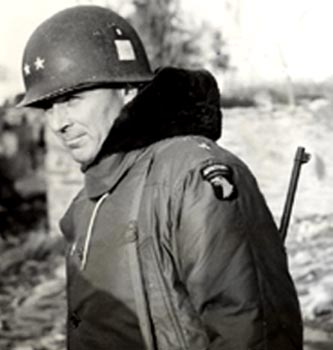 Maxwell Davenport Taylor assumed command of the 101st division in the spring of 1944, after Bill Lee, the erstwhile C.O. suffered a heart attack. A highly-educated, and well traveled graduate of West Point, Taylor was the former Divarty Commander of the 82nd Airborne. He arrived as a Brigadier General but was promoted to Major General (2 stars), after Normandy. Except for a week during the Bulge, Taylor would command the 101st Airborne during all its WW2 combat. This photo at left is a U.S. Army picture taken before Market Garden in mid 1944. The other was made in Noville, Belgium in January, 1945 by ACME photographer Charles Haacker, for the War Picture Pool. After WW2 Taylor served as Superintendent of the USMA at West Point, U.S. Army Chief of Staff, and also on the notorious 'Council of Elders' at the Pentagon during the Vietnam War.
Maxwell Davenport Taylor assumed command of the 101st division in the spring of 1944, after Bill Lee, the erstwhile C.O. suffered a heart attack. A highly-educated, and well traveled graduate of West Point, Taylor was the former Divarty Commander of the 82nd Airborne. He arrived as a Brigadier General but was promoted to Major General (2 stars), after Normandy. Except for a week during the Bulge, Taylor would command the 101st Airborne during all its WW2 combat. This photo at left is a U.S. Army picture taken before Market Garden in mid 1944. The other was made in Noville, Belgium in January, 1945 by ACME photographer Charles Haacker, for the War Picture Pool. After WW2 Taylor served as Superintendent of the USMA at West Point, U.S. Army Chief of Staff, and also on the notorious 'Council of Elders' at the Pentagon during the Vietnam War.
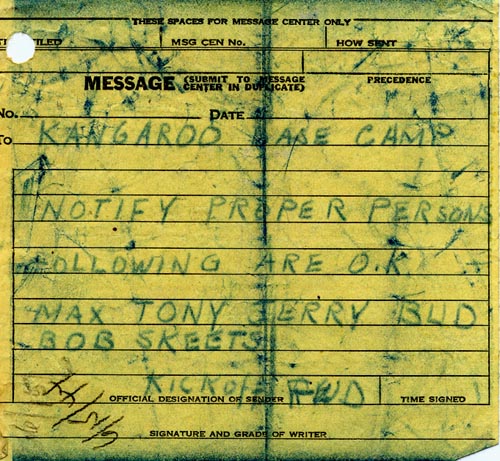 This Memo, was sent to KICKOFF Fwd, the 502PIR's forward HQ from 101st Airborne Division Base Camp on 15 June, 1944. It gives approved radio nicknames for various unit commanders within the division: MAX is Max Taylor,the Commanding General of the division. TONY is B.G. Anthony McAuliffe, who was divisional artillery commander, then became deputy division commander after the death of General Don F. Pratt in a D-Day glider crash. He was later acting division commander at Bastogne. JERRY is Gerald Higgins the Chief of Staff. BUD is Colonel Joseph H.Harper, C.O. of the 327th GIR. BOB is Colonel Robert Sink of the 506th PIR. SKEETS is Colonel Howard R. Johnson, C.O. of the 501 PIR. From Ben Weisberg's papers, courtesy Ruth W.
This Memo, was sent to KICKOFF Fwd, the 502PIR's forward HQ from 101st Airborne Division Base Camp on 15 June, 1944. It gives approved radio nicknames for various unit commanders within the division: MAX is Max Taylor,the Commanding General of the division. TONY is B.G. Anthony McAuliffe, who was divisional artillery commander, then became deputy division commander after the death of General Don F. Pratt in a D-Day glider crash. He was later acting division commander at Bastogne. JERRY is Gerald Higgins the Chief of Staff. BUD is Colonel Joseph H.Harper, C.O. of the 327th GIR. BOB is Colonel Robert Sink of the 506th PIR. SKEETS is Colonel Howard R. Johnson, C.O. of the 501 PIR. From Ben Weisberg's papers, courtesy Ruth W.
A.C."NUTS!"McAuliffe
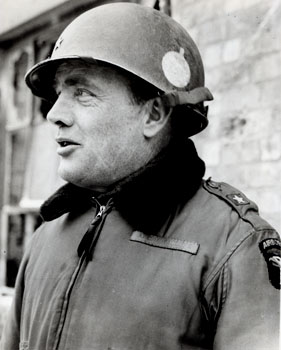 B.G. Anthony McAuliffe was Divisional Artillery commander of the 101st, except for a brief period in Normandy when he became Deputy Division Commander, following General Pratt's death.
MacAuliffe reverted to his role as DIVARTY commander and while at the Bastogne siege, served as Acting Divisional Commander for
the first crucial week. At Bastogne, the 101st was surrounded by seven German divisions. McAuliffe's place in world history was assured when he replied "Nuts!" to a formal German surrender ultimatum on 22 December, 1944. Men who served with Mac claim that he never used true profanity when speaking, thus any rumors that his initial verbal response to the German ultimatum was in stronger language, are false.
B.G. Anthony McAuliffe was Divisional Artillery commander of the 101st, except for a brief period in Normandy when he became Deputy Division Commander, following General Pratt's death.
MacAuliffe reverted to his role as DIVARTY commander and while at the Bastogne siege, served as Acting Divisional Commander for
the first crucial week. At Bastogne, the 101st was surrounded by seven German divisions. McAuliffe's place in world history was assured when he replied "Nuts!" to a formal German surrender ultimatum on 22 December, 1944. Men who served with Mac claim that he never used true profanity when speaking, thus any rumors that his initial verbal response to the German ultimatum was in stronger language, are false.
Gerry HIGGINS
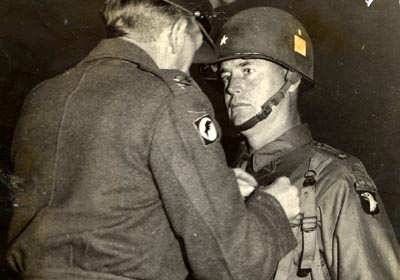 Gerald Higgins, Chief of Staff of the 101st Airborne Division
was a behind the scenes operator who kept the division on the right track. A member of the pre war Regular Army, Higgins had predicted the coming war with Japan as early as 1938. An early parachutist, Higgins was promoted to LTC and made Chief of Staff under General Bill Lee while at Ft Bragg. Captain 'Ike' Phillips of the 502 said:"It was Higgins that made the 101st what it was, under Generals Lee, Taylor, and McAuliffe." U.S. Army photo, c/o N. Wierzbowski.
Gerald Higgins, Chief of Staff of the 101st Airborne Division
was a behind the scenes operator who kept the division on the right track. A member of the pre war Regular Army, Higgins had predicted the coming war with Japan as early as 1938. An early parachutist, Higgins was promoted to LTC and made Chief of Staff under General Bill Lee while at Ft Bragg. Captain 'Ike' Phillips of the 502 said:"It was Higgins that made the 101st what it was, under Generals Lee, Taylor, and McAuliffe." U.S. Army photo, c/o N. Wierzbowski.
Jumpy Johnson
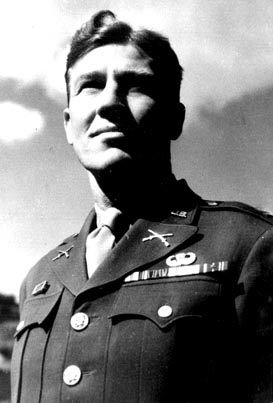 Born 18 June, 1903 Colonel Howard R. Johnson was variously known as "Jumpy" or "Skeets". He grew up in the Washington D.C. area, graduated from Central High School, and attended Annapolis Naval Academy. He left before graduating to join the Army Air Corps in Texas. Washed out of pilot training due to insufficient side vision, Johnson languished in the Regluar Army through the long interim war period, serving time at Panama, Tientsing China, Ft Sill Oklahoma, and Ft Meade, MD. While in China, Johnson observed the military and diplomatic methods of the Japanese Army and gained an intense dislike of Japanese Imperialism.
After flipping a jeep during a wild test drive and breaking several vertebrates in his back, Johnson made an amazing recovery. He was given command of the 501 PIR in November, 1942. He molded it into one of the best trained regiments in the entire U.S. Army. Suffering personal trepidation about parachute jumping, Johnson gained the nickname of "Jumpy" as he drove himself to make over 130 jumps before his regiment sailed for England. Although he did not survive to see the victory in 1945, Jumpy Johnson was a superbly conditioned and mentally intolerant officer, with no patience for weakness or delay of any kind. Colonel Johnson's life was cut short by a close-exploding artillery shell near Heteren, Holland on 8 October, 1944. One of his officers observed:"In an age of faint ideals and quibbling uncertainties, he was like a steel knife."
photo courtesy Elliot Johnson.
Born 18 June, 1903 Colonel Howard R. Johnson was variously known as "Jumpy" or "Skeets". He grew up in the Washington D.C. area, graduated from Central High School, and attended Annapolis Naval Academy. He left before graduating to join the Army Air Corps in Texas. Washed out of pilot training due to insufficient side vision, Johnson languished in the Regluar Army through the long interim war period, serving time at Panama, Tientsing China, Ft Sill Oklahoma, and Ft Meade, MD. While in China, Johnson observed the military and diplomatic methods of the Japanese Army and gained an intense dislike of Japanese Imperialism.
After flipping a jeep during a wild test drive and breaking several vertebrates in his back, Johnson made an amazing recovery. He was given command of the 501 PIR in November, 1942. He molded it into one of the best trained regiments in the entire U.S. Army. Suffering personal trepidation about parachute jumping, Johnson gained the nickname of "Jumpy" as he drove himself to make over 130 jumps before his regiment sailed for England. Although he did not survive to see the victory in 1945, Jumpy Johnson was a superbly conditioned and mentally intolerant officer, with no patience for weakness or delay of any kind. Colonel Johnson's life was cut short by a close-exploding artillery shell near Heteren, Holland on 8 October, 1944. One of his officers observed:"In an age of faint ideals and quibbling uncertainties, he was like a steel knife."
photo courtesy Elliot Johnson.
H.W.O.KINNARD
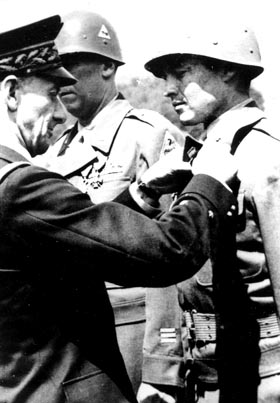 Harry William Osborne Kinnard graduated West Point 1939. He was original S-3 Plans & Operations officer for the 501 PIR. During the Normandy campaign, he was made acting commander of first battalion, which had lost a devastating number of officers and men. He ran the battalion like a company until replacements arrived. Harry jumped into Holland still C.O. of 1st Bn., with Sammie N. Homan as his EXO. Small in stature, Harry has always worn his dignity like a higher rank, General Taylor was impressed and brought Kinnard up to the Division staff as G-3, after Hank Hannah was WIA at St Oedenrode. It was Harry who suggested that Tony McAuliffe word his formal reply to the German surrender ultimatum with his original verbal reaction:"Nuts!" Kinnard remained in the Army, attained the rank of general and commanded the First Cavalry Division in Vietnam in 1965. U.S. Army photo
Harry William Osborne Kinnard graduated West Point 1939. He was original S-3 Plans & Operations officer for the 501 PIR. During the Normandy campaign, he was made acting commander of first battalion, which had lost a devastating number of officers and men. He ran the battalion like a company until replacements arrived. Harry jumped into Holland still C.O. of 1st Bn., with Sammie N. Homan as his EXO. Small in stature, Harry has always worn his dignity like a higher rank, General Taylor was impressed and brought Kinnard up to the Division staff as G-3, after Hank Hannah was WIA at St Oedenrode. It was Harry who suggested that Tony McAuliffe word his formal reply to the German surrender ultimatum with his original verbal reaction:"Nuts!" Kinnard remained in the Army, attained the rank of general and commanded the First Cavalry Division in Vietnam in 1965. U.S. Army photo
Julian EWELL
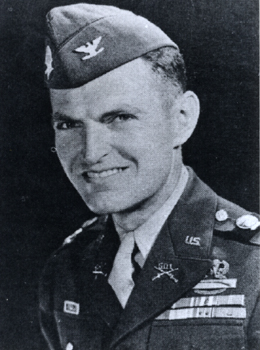 Juilian J. Ewell, West Point 1939, served in the early Provisional Parachute Group HQ and assumed command of 3/501 after Major Raymond "Big Red" Shelby was transfered out. Ewell
commanded Third Battalion on the Normandy mission and led troops
into Pouppeville on D-Day. Ewell also helped drive German troops out of St Come du Mont on 8 June, 1944, during the 'snafu engagement', and his troops took Hill 30 on 12 June. Noted for his slow drawling and sarcastic sense of humor, Ewell was too critical of his peers to be 'popular' with the other officers, but his men loved him. After Hill 30, Ewell commented "I had about a Boy Scout Troop left to command". Ewell continued leading 3/501 in Holland and assumed command of the regiment in October when Jumpy Johnson was KIA. The jeep carrying Colonel Johnson to surgery paused as Ewell said goodbye. Johnson's last words to Ewell were "Julian-look after my men." Johnson died on the operating table. Command of 3/501 passed to LTC George Griswold. Colonel Ewell was seriously wounded at Recogne, Belgium on 9 January, 1945, and regimental command passed to LTC Robert A. Ballard, the erstwhile 2d Bn C.O.
Juilian J. Ewell, West Point 1939, served in the early Provisional Parachute Group HQ and assumed command of 3/501 after Major Raymond "Big Red" Shelby was transfered out. Ewell
commanded Third Battalion on the Normandy mission and led troops
into Pouppeville on D-Day. Ewell also helped drive German troops out of St Come du Mont on 8 June, 1944, during the 'snafu engagement', and his troops took Hill 30 on 12 June. Noted for his slow drawling and sarcastic sense of humor, Ewell was too critical of his peers to be 'popular' with the other officers, but his men loved him. After Hill 30, Ewell commented "I had about a Boy Scout Troop left to command". Ewell continued leading 3/501 in Holland and assumed command of the regiment in October when Jumpy Johnson was KIA. The jeep carrying Colonel Johnson to surgery paused as Ewell said goodbye. Johnson's last words to Ewell were "Julian-look after my men." Johnson died on the operating table. Command of 3/501 passed to LTC George Griswold. Colonel Ewell was seriously wounded at Recogne, Belgium on 9 January, 1945, and regimental command passed to LTC Robert A. Ballard, the erstwhile 2d Bn C.O.
General Ewell recently told me: "What our men knew about TACTICS in WW2 would've fit on a postage stamp. Wanta know how they won their battles? Sheer GUTS-that was what paid off in Europe." Ewell survived WW2 and remained in the Army, attaining General rank. In 1967, he commanded the 9th Infantry Division in the Mekong Delta area of Vietnam.
LTC BENJAMIN WEISBERG
377th PARACHUTE FIELD ARTILLERY Bn.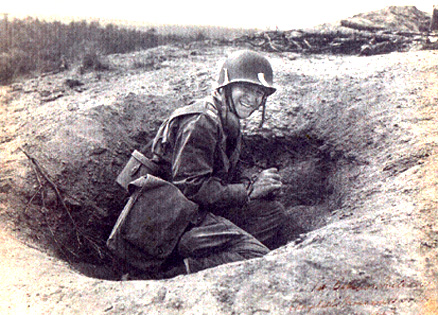 Ben Weisberg was born 25 October, 1911, in Sioux City, IA, but was raised in NYC. His parents had escaped the Progroms in Poland and emigrated to the U.S. near the turn of the century.
Ben obtained an engineering degree from NYU, while working nights at the Post Office. He trained in aeronautical engineering but could not fly because he wore corrective glasses for his vision. He joined a field artillery unit in the N.Y. National Guard. Federalized to active service after Pearl Harbor, Ben sought Airborne duty and was given command of the 377th PFA battalion, which did not yet exist. Working in close cooperation with Major Courtney'Dap'Neilson and Captain William E. Brubaker, Ben molded his newly jump-qualified enlisted men into a finely trained unit. Three firing batteries,an anti tank and anti aircraft battery, and a service and HQ battery were formed. A new doctrine for dropping and deploying 75mm pack howitzers was created. These weapons, which could be dropped in sections by parachute, were to support the 502nd PIR, the TO&E Parachute Regiment of the 101st Airborne.
Ben Weisberg was born 25 October, 1911, in Sioux City, IA, but was raised in NYC. His parents had escaped the Progroms in Poland and emigrated to the U.S. near the turn of the century.
Ben obtained an engineering degree from NYU, while working nights at the Post Office. He trained in aeronautical engineering but could not fly because he wore corrective glasses for his vision. He joined a field artillery unit in the N.Y. National Guard. Federalized to active service after Pearl Harbor, Ben sought Airborne duty and was given command of the 377th PFA battalion, which did not yet exist. Working in close cooperation with Major Courtney'Dap'Neilson and Captain William E. Brubaker, Ben molded his newly jump-qualified enlisted men into a finely trained unit. Three firing batteries,an anti tank and anti aircraft battery, and a service and HQ battery were formed. A new doctrine for dropping and deploying 75mm pack howitzers was created. These weapons, which could be dropped in sections by parachute, were to support the 502nd PIR, the TO&E Parachute Regiment of the 101st Airborne.
Weisberg had enjoyed a comfortable working relationship with both General Bill Lee, the original C.O. of the 101st Airborne, as well as Tony McAuliffe, the DIVARTY commander. But this changed when Max Taylor assumed command of the division. Taylor
found a reason to relieve LTC Weisberg after the Normandy invasion. Details of this will be found in my 4th book. The
85th TCS of the 437th TCG had badly misdropped Weisberg's battalion in France, with all 18 planeloads (approximately 180 of Weisberg's men) landing on the wrong map. The 81st and 82nd Troop Carrier Squadrons of the 436th TCG, also misdropped the remaining 36 sticks carrying the 377th PFA Bn., with only 2 sticks landing within 2 miles of the planned DZ. Many officers and men of the 377th were killed or captured in Normandy and the survivors fought well as infantrymen. All but one of their howitzers had been lost on the mis drops. Because of the seperation of men from their howitzers in Normandy, most of the 377th entered Holland in gliders.
The unit was able to come back from a disastrous start in Normandy, to establish a superior record in Holland and Bastogne. LTC Weisberg was very popular with his men and it was regrettable that he missed being with the unit he created during their fruition as a team in battle. Letters he received later indicate his men credited Ben for the success of the 377th in later combat.
After leaving the 101st, Ben went to an officers' pool in London, then was assigned as EXO of SAARF. He
traveled through Germany and postwar Japan with a bomb damage survey unit, then spent four years stationed at Dachau for occupation duties. Ben Weisberg served in Korea with KMAG and
spent a full career in the Army, with stations around the globe.
He passed away in December of 1982. Ben is survived by his wife, Ruth, whom he met as a WAC lieutenant aboard the S.S. Strathnaver, enroute to England in 1943. One of his daughters, Courtnay, was named after his EXO, Courtney 'Dap'Neilson, who was killed in Normandy.
OLD MOE
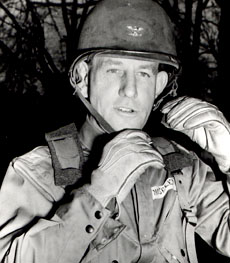
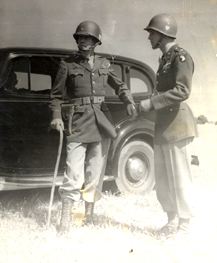 Colonel George Van Horn Moseley commanded the 502nd PIR until
shortly after he broke his leg on the drop into Normandy. He
was a West Point graduate and curiously, his father, a retired U.S. Army general was an outspoken public advocate of the American Nazi Bund. From historian Mike Detrez comes this Bio of Moseley: "Old Moe", a third generation Army man and a West Pointer was the original Commanding Officer of the 502 PIR.
Moseley's father, a two star general (West Point 1899) had been
Deputy Chief of Staff of the Army, under Douglas MacArthur.
Colonel George Van Horn Moseley commanded the 502nd PIR until
shortly after he broke his leg on the drop into Normandy. He
was a West Point graduate and curiously, his father, a retired U.S. Army general was an outspoken public advocate of the American Nazi Bund. From historian Mike Detrez comes this Bio of Moseley: "Old Moe", a third generation Army man and a West Pointer was the original Commanding Officer of the 502 PIR.
Moseley's father, a two star general (West Point 1899) had been
Deputy Chief of Staff of the Army, under Douglas MacArthur.
Colonel Moseley made enormous demands both of himself and those under him. Veterans of the 502, justly proud of their combat record, insisted much credit was due their commander, despite the fact that he lasted only a few days in Normandy. On the Normandy drop, Moseley jumped from the lead aircraft of the four leading serials of planes. These carried the 502 PIR and 377th PFA Bn. LTC Weisberg, the 377th C.O. was jumping right behind Moseley to coordinate artillery support in taking the 502's
primary objective, the artilley battery near St Martin De Varreville. Mosely had a bad landing and broke his ankle on the jump. His bodyguards (including Sky Jackson and Victor Nelson) placed him in a wheelbarrow pushed by his orderly, Carmen Fascinella, and he established a moving C.P. after receiving first aid.
LTC Mike Michaelis described some very erratic behavior by Moseley in Normandy and later claimed that he had pulled a gun on him when he (Michaelis) refused to send a patrol on a suicidal assignment. Moseley said "I'm in command here and I'm telling you what to do!" Michaelis replied "Not me sir, if you want that, you'd better relieve me." (Michaelis later stated: "He pulled his pistol and I had to dive to keep from getting shot.") When General McAuliffe observed Moseley circa June 8th, the colonel was in sight of the retreating Germans, his leg in a cast. 'Old Moe' was barking commands from his wheelbarrow. In spite of his pleas to remain in action, Moseley received a direct order to relinquish command to his EXO, Mike Michaelis.
After two years of training the 502 regiment, Moseley was ordered to leave Normandy only two days after entering battle. General Max Taylor overruled his objections to being relieved. In summing up, Michaelis later said: "Moseley was a superb, tough trainer. He accepted no excuses. He could strike terror into the heart of God. Exactly what you needed in preparation for combat. Let me put it this way. He wasn't popular, but he gave the outfit a damned fine discipline. All you had to do was whisper and the men came on the run. But he wasn't a good tactician." 'Old Moe' never did return to the Airborne and he retired disabled from the Army in 1945. In postwar years he served as a civilian aide in MacArthur's Tokyo Headquarters."
Webmaster's note: The closeup photo above, was taken in England, on pre D-day night maneuvers, by Mike Musura. The other photo was made after Normandy, in the summer of '44 as Moseley arrived to receive his Legion of Merit Medal. With him is his successor, Mike Michaelis. (photos c/o Mike Musura and Dick Ladd H&H S-2 502).
IRON MIKE
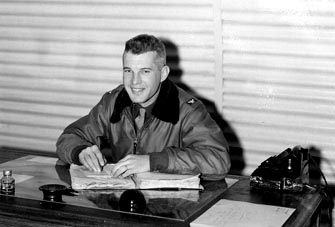 LTC John H."Iron Mike"Michaelis was EXO (2d in command) of the 502 PIR, under Colonel George Moseley. After Moseley suffered a severe broken leg on the Normandy jump, Michaelis assumed command of the 502 Regiment. This command was short-lived as Michaelis was wounded seriously early in the Holland campaign. He relinquished command of the 502 to LTC Chappuis at that time. Iron Mike would make headlines again in the 1950's for his exploits as commander of the 27th Infantry "Wolfhounds" Regiment in the Korean War. His troops called him "Colonel Mike" or just Mike Michaelis, despite his actual name of John. Musura photo
LTC John H."Iron Mike"Michaelis was EXO (2d in command) of the 502 PIR, under Colonel George Moseley. After Moseley suffered a severe broken leg on the Normandy jump, Michaelis assumed command of the 502 Regiment. This command was short-lived as Michaelis was wounded seriously early in the Holland campaign. He relinquished command of the 502 to LTC Chappuis at that time. Iron Mike would make headlines again in the 1950's for his exploits as commander of the 27th Infantry "Wolfhounds" Regiment in the Korean War. His troops called him "Colonel Mike" or just Mike Michaelis, despite his actual name of John. Musura photo
Silent Steve and Hopalong
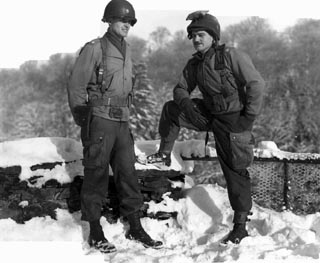 LTC Steve Chappuis (above left), was
aptly known as "Silent Steve". He commanded the 2d Bn of the 502
through Normandy and became the new regimental commander after Michaelis was WIA. He was a tall, competent man of few words and strong principles, and his men discovered he could throw grenades a long distance during the battle at Best. Colonel
Chappuis received the D.S.C. from General Patton at Bastogne, and remained in command of the 502 for the duration of WW2.
LTC Steve Chappuis (above left), was
aptly known as "Silent Steve". He commanded the 2d Bn of the 502
through Normandy and became the new regimental commander after Michaelis was WIA. He was a tall, competent man of few words and strong principles, and his men discovered he could throw grenades a long distance during the battle at Best. Colonel
Chappuis received the D.S.C. from General Patton at Bastogne, and remained in command of the 502 for the duration of WW2.
LTC Patrick Cassidy (above right) was original 1st battalion commander of the 502 PIR. Naturally known as "Hopalong" to his troops, Cassidy's men took the German artillery garrison at objective XYZ in Normandy, and established roadblocks along exits 3 and 4 at Foucarville and St Germain de Varreville. S.L.A. Marshall later wrote that Cassidy's battalion did "the one best job for America on D-Day." Cassidy was later EXO of the 502 Regiment, his former battalion being commanded by LTC Thomas Sutliffe in Holland, and John Hanlon in Bastogne. This photo was made in January, 1945 near the 502's regimental C.P. at Rolle, Belgium. U.S.Army photo courtesy Nadine
LTC Robert G. Cole- CMH
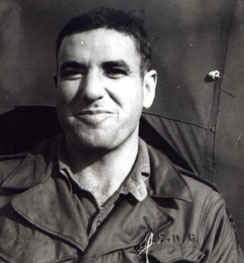 A 1939 graduate of West Point, Bob Cole served in the 15th Infantry,
with Dwight Eisenhower before becoming a paratroop officer. He
ruled his battalion 3/502 with an iron hand. Big, rugged, and loud, most of his men feared him. Cole lead 3/502 on a bayonet charge on 11 June, 1944. In the fighting which followed, his battalion and first battalion, broke German resistance above Carentan, France. Cole was written-up for a Medal of Honor, but never lived to wear it, as a German sniper killed him in Holland in September, 1944. photo courtesy Captain Fred Hancock.
A 1939 graduate of West Point, Bob Cole served in the 15th Infantry,
with Dwight Eisenhower before becoming a paratroop officer. He
ruled his battalion 3/502 with an iron hand. Big, rugged, and loud, most of his men feared him. Cole lead 3/502 on a bayonet charge on 11 June, 1944. In the fighting which followed, his battalion and first battalion, broke German resistance above Carentan, France. Cole was written-up for a Medal of Honor, but never lived to wear it, as a German sniper killed him in Holland in September, 1944. photo courtesy Captain Fred Hancock.
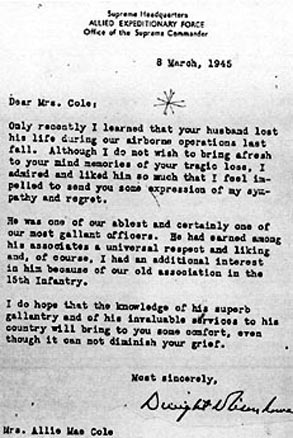 When LTC Cole was KIA by a sniper in the Zonsche Forest, his widow, Allie Mae received letters from many officers and men who had served with him. The one shown above came from the highest ranking friend who wrote. courtesy Allie Mae Beall
When LTC Cole was KIA by a sniper in the Zonsche Forest, his widow, Allie Mae received letters from many officers and men who had served with him. The one shown above came from the highest ranking friend who wrote. courtesy Allie Mae Beall




















